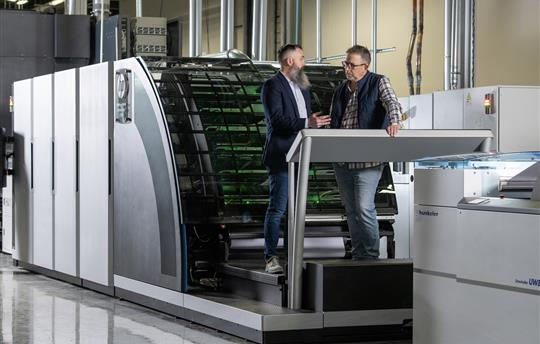RRD Facility Spotlight: RRD Austell
2/5/2025

RRD Austell, strategically located just 10 minutes from downtown Atlanta, serves an impressive array of industries. Their clients range from financial institutions, hospitals, and manufacturers to retail operations, insurance/managed care providers, healthcare organizations, automotive dealers, and more. They offer customers a full range of digital print-on-demand (with variable-data capabilities), short-run digitally printed books and brochures, and offset printing, plus inventory management, kitting services, and warehousing and distribution services.
RRD Austell’s 140,560-square-foot facility is also in the midst of a significant transformation into a best-in-class commercial print hub: A recent investment by RRD has brought in first-to-market robotics and automation technologies and advanced, high-capacity digital presses. This expansion will double the site’s workforce — and empower a benchmark for rapid, high-volume digital production and high-speed hyper-personalization.
“This new investment allows us to service more clients with an even higher degree of efficiency,” says Kyle Mankowski, President, RRD Austell. “We’ll be among the first commercial print manufacturing facilities in America to implement industry-leading autonomous technology.”
We caught up with Kyle to learn more about the Austell facility, their new offerings, and their plans for the future.
What about RRD Austell makes it unique in the marketplace?
Kyle Mankowski (KM): Our differentiator has to do with the breadth and scope of capabilities, and this investment in technology, assets, and personnel will further expand that differentiation. Our competitors don’t have the network, infrastructure, and depth in their service offerings that RRD brings to the table. Our new investment strengthens the backbone of our print production, distribution, and dynamic assembly capabilities.
The facility itself has an expansive range of services and product offerings that extend beyond its physical location into the larger network of RRD facilities.
If you had to narrow it down to one thing, what do you consider your facility’s forte?
KM: It’s our ability to provide communications on a one-to-one basis or a one-to-many basis in a very short period of time, and to do so with a high degree of accuracy and effectiveness. We can produce one piece of personalized communication and deliver it to an individual — and, just as efficiently, we can scale up the same personalized communications to service thousands or tens of thousands of people or addresses. It’s this range in scale and implied efficiency that separates us from our competitors.
How will the new printing equipment and technology enable you to better serve your clients’ needs?
KM: The investment in this equipment, technology, and infrastructure enables us to increase our capacity and capabilities when it comes to servicing our clients’ communications needs. The benefits are immediate — including the ability to output any quantity on a variety of substrates, and to tailor a company’s messaging to individual consumers, and on scale, each based on their specific relationship with the brand.
In addition, although the overall footprint of the facility hasn’t changed as a result of our equipment investment, we have expanded the 12,000-square-foot print center within the operation to approximately 30,000 square feet. This comfortably accommodates our new digital print engines and our new auxiliary finishing equipment.
How will the new robotic technology impact your facility? And how will it benefit your customers?
KM: This new technology will primarily serve the new print engines we’re installing. In addition, the autonomous material-handling equipment will retrieve, relocate, and strategically move material throughout the facility in a highly efficient fashion. We’ll be reducing the need for traditional material-handling processes. The technology will largely augment — not replace — the human element as it relates to our production processes.
What role do you see RRD Austell playing in your clients' evolution? How do you help clients evolve so they can keep pace with their customers' demands?
KM: One of the things we excel at is being an agent on behalf of our clients — proactively bringing solutions to the table based on challenges we’ve seen in their verticals and in other markets. We want to be viewed as a genuine partner and a solutions provider, whether or not we’re immediately selling the client a solution. Our clients have been seeking even more options when it comes to such variables as personalized messaging, colors, substrates, coatings, and finishing — features that will help set them apart in their markets. With our recent investments in new print technologies and robotics, our clients will find that those options have been greatly expanded. Plus, we’ll be able to provide faster turnaround times. If we can continue to bring ideas and solutions to the table — whether those are construction alternatives, improved workflows, or material substitutions to reduce costs or increase speed to market — we can keep our clients engaged, be it in direct support of a project or program, or in a consultative capacity.
Anything else you’d like to share?
KM: I don’t want to neglect to reference our kitting and warehousing services. As with other areas in the facility, our warehouse is going through its own transformation. We’re increasing our warehouse capacity and bringing in specialized material-handling equipment. This will enable us to add additional storage capacity while also improving throughput, allowing us to provide tighter turn time on client demand. We’ll be able to operate far more efficiently as a result — for inbound and outbound shipments.